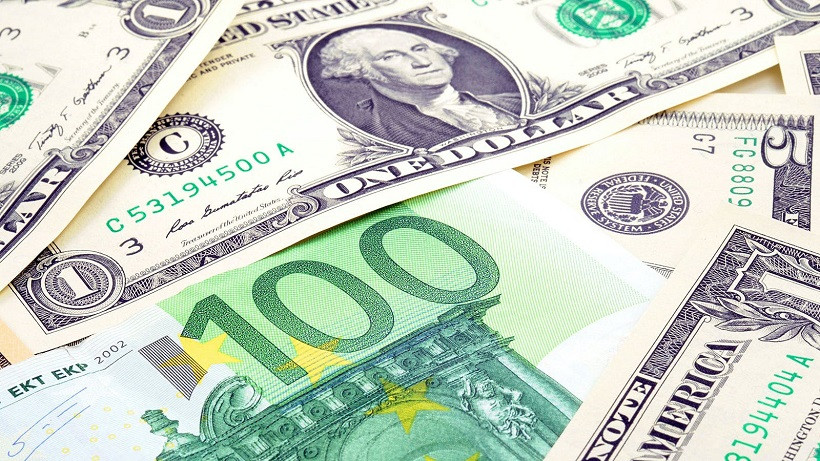The euro-dollar pair, apparently, has formed a price range within which it is trading, demonstrating wave-like movements. The upper limit of this echelon corresponds to the 1.1050 mark (the middle line of the Bollinger Bands indicator on the daily chart), and the lower one corresponds to the 1.0960 mark. Over the past few days, the pair has been "walking" within this almost 100-point range, reacting primarily to the external fundamental background. Macroeconomic fundamentals are secondary, as are the comments of the Federal Reserve and European Central Bank representatives.
On the one hand, traders do not ignore the most important reports or statements of central bank officials, but on the other hand, geopolitics always takes priority. Therefore, price movements within the day are unpredictable - the dollar responds impulsively to the rapidly changing news flow. At the same time, neither bears nor bulls of EUR/USD risk opening large positions, given the general uncertainty. Therefore, intraday volatility "fits" within the above-mentioned almost 100-point price range. Of course, price impulses may go beyond this echelon, but while the market is under the yoke of geopolitical uncertainty, traders are unlikely to risk organizing a large-scale offensive - both to the upside and to the downside.

In general, traders have to put up with the information vacuum that has formed around the negotiation process between Russia and Ukraine. The details of the negotiations are not disclosed for obvious reasons, and the comments voiced by the representatives of the delegations are sketchy and uninformative. The very fact of negotiations allows EUR/USD bulls to "stay afloat", since in the vast majority of cases such dialogues end with the conclusion of a compromise agreement. But on the other side of the scale is the lack of any information about the dynamics of the negotiation process, and, in fact, its prolonged duration. This is already an argument in favor of the US currency, which continues to be in high demand as a protective tool.
It should also be noted that in recent days the market has focused its attention on several other fundamental factors - also of a geopolitical nature. We are talking about the visit of US President Joe Biden to Europe and Poland's proposal to organize a "NATO peacekeeping contingent." These information flows have strengthened the anti-risk sentiment in the market, as they have increased the risks of escalation of the situation in Eastern Europe. The euro-dollar pair reacted accordingly, dropping to the lower limit of the above price range (intraday low - 1.0966).
However, subsequent statements lowered the heat, allowing EUR/USD bulls to go on the counterattack again. In particular, NATO Secretary General Jens Stoltenberg said today that the Alliance will not deploy troops on the territory of Ukraine to avoid further escalation. This is how he commented to journalists on Poland's proposal to send a NATO peacekeeping mission. After these words, the EUR/USD pair once again turned 180 degrees and returned to the borders of the 10th figure. However, the upward momentum also did not continue. This suggests that traders are not ready for large-scale offensive actions, both towards the downside and towards the upside. Price impulses fade away as soon as they begin.
As for the release of macroeconomic reports, there is complete apathy here. For example, today EUR/USD traders ignored the March PMI indices. Almost all of them came out (surprisingly) in the green zone, although they reflected a slight decrease relative to February. However, most experts expected a deeper decline - both in the service sector and in the manufacturing sector (and especially in the manufacturing sector). For example, the German index of business activity in the manufacturing sector in March came out at 57.6 points (in February it was at 58.4), while analysts predicted a decline to 55 points. A similar trend was demonstrated by the pan-European index of business activity in the manufacturing sector.
By the way, US macroeconomic reports also came out in the green zone today, which did not prevent the dollar from weakening throughout the market in the afternoon. For example, the growth rate of initial applications for unemployment benefits today came out at around 187,000. This is the least weekly increase in this indicator. In turn, the index of business activity in the US manufacturing sector jumped to 58.5 points in March. This is the best result since September 2021.
However, all the above reports were ignored by the market. The pair reacts only to geopolitical fundamental factors, which are difficult to predict a priori. The hawkish comments of the Fed representatives (Powell, Waller, Barkin, Bullard) are also of secondary importance now: almost all Fed officials admit the option of a more aggressive tightening of monetary policy, but only when the geopolitical situation stabilizes.
All this suggests that in the medium term, the EUR/USD pair will continue to fluctuate within the 1.1050-1.0960 price range, reacting impulsively to the external fundamental background. In such conditions, it is most expedient to take a wait-and-see position, or to open trading orders from the borders of the above echelon - in the event that, when approaching its borders, the momentum will show signs of fading.













